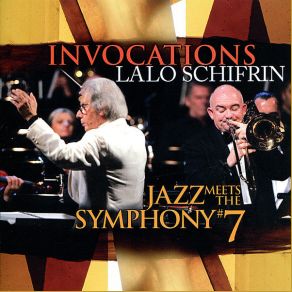Invocations - Jazz Meets the Symphony #7
Download links and information about Invocations - Jazz Meets the Symphony #7 by Lalo Schifrin. This album was released in 2011 and it belongs to Jazz genres. It contains 7 tracks with total duration of 01:07:17 minutes.

|
|
|---|---|
| Artist: | Lalo Schifrin |
| Release date: | 2011 |
| Genre: | Jazz |
| Tracks: | 7 |
| Duration: | 01:07:17 |
| Buy it NOW at: | |
| Buy on iTunes $9.99 | |
Tracks
[Edit]| No. | Title | Length |
|---|---|---|
| 1. | Trombone Fantasy | 8:59 |
| 2. | Groovin' High | 9:25 |
| 3. | Invocations | 9:13 |
| 4. | Summer Dance | 6:28 |
| 5. | Reverie | 5:28 |
| 6. | Etude In Rhythm | 15:56 |
| 7. | Here 'Tis | 11:48 |
Details
[Edit]The person most clearly invoked on Lalo Schifrin's Invocations: Jazz Meets the Symphony #7 is his old boss Dizzy Gillespie, who claims composition credit on "Groovin' High" (with Charlie Parker) and "Here ‘Tis." The Schifrin "Jazz Meets the Symphony" series finds the veteran film composer and jazz pianist assembling a small jazz band to interact with a symphony orchestra on his compositions and arrangements; here, he, horn player James Morrison, bassist Pierre Boussaguet, and drummer Tom Gordon joined the Czech National Symphony Orchestra in Prague in July 2010. The problem in mixing jazz music and musicians with an orchestra, the conventional wisdom would have it, is that an improvisatory form and its practitioners have to rub shoulders with people accustomed to reading and playing notes as written. Schifrin gets around this problem, however, much in the way swing bandleaders did in the 1930s and ‘40s. He has the orchestra play set sections, sometimes dropping out entirely, and he has his soloists fit their solos into specific spots at specific tempos. Those tempos vary from piece to piece, with the languid "Invocations" succeeded by the playfully Renaissance-like "Summer Dance" and then the much calmer "Reverie." Another way of getting the musicians to work well together is to vary their level of participation. Generally, the more improvisatory the music, the less the orchestra is to be heard. In "Etude in Rhythm," its participation is much reduced, and for "Here ‘Tis," it lays out completely. Still, this album and the series of which it is a part, must be considered one of the more successful experiments in combining jazz and classical elements into a hybrid, which is not surprising, given that Schifrin has devoted much of his career to doing exactly that.